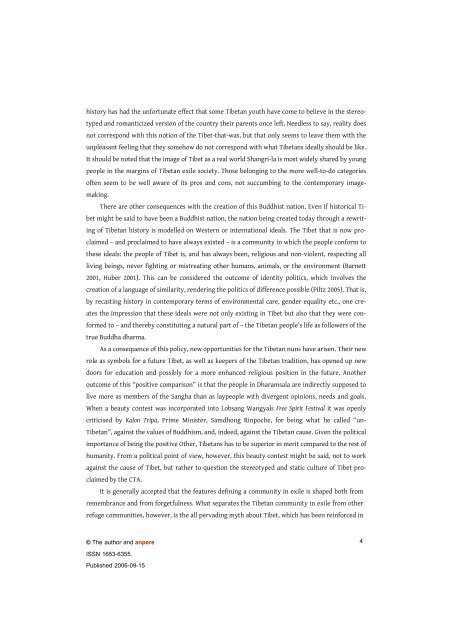Being Tibetan: Internet and Public Identity among ... - anpere.net
Being Tibetan: Internet and Public Identity among ... - anpere.net
Being Tibetan: Internet and Public Identity among ... - anpere.net
You also want an ePaper? Increase the reach of your titles
YUMPU automatically turns print PDFs into web optimized ePapers that Google loves.
history has had the unfortunate effect that some <strong>Tibetan</strong> youth have come to believe in the stereotyped<br />
<strong>and</strong> romanticized version of the country their parents once left. Needless to say, reality does<br />
not correspond with this notion of the Tibet-that-was, but that only seems to leave them with the<br />
unpleasant feeling that they somehow do not correspond with what <strong>Tibetan</strong>s ideally should be like.<br />
It should be noted that the image of Tibet as a real world Shangri-la is most widely shared by young<br />
people in the margins of <strong>Tibetan</strong> exile society. Those belonging to the more well-to-do categories<br />
often seem to be well aware of its pros <strong>and</strong> cons, not succumbing to the contemporary imagemaking.<br />
There are other consequences with the creation of this Buddhist nation. Even if historical Tibet<br />
might be said to have been a Buddhist nation, the nation being created today through a rewriting<br />
of <strong>Tibetan</strong> history is modelled on Western or international ideals. The Tibet that is now proclaimed<br />
– <strong>and</strong> proclaimed to have always existed – is a community in which the people conform to<br />
these ideals: the people of Tibet is, <strong>and</strong> has always been, religious <strong>and</strong> non-violent, respecting all<br />
living beings, never fighting or mistreating other humans, animals, or the environment (Bar<strong>net</strong>t<br />
2001, Huber 2001). This can be considered the outcome of identity politics, which involves the<br />
creation of a language of similarity, rendering the politics of difference possible (Piltz 2005). That is,<br />
by recasting history in contemporary terms of environmental care, gender equality etc., one creates<br />
the impression that these ideals were not only existing in Tibet but also that they were conformed<br />
to – <strong>and</strong> thereby constituting a natural part of – the <strong>Tibetan</strong> people’s life as followers of the<br />
true Buddha dharma.<br />
As a consequence of this policy, new opportunities for the <strong>Tibetan</strong> nuns have arisen. Their new<br />
role as symbols for a future Tibet, as well as keepers of the <strong>Tibetan</strong> tradition, has opened up new<br />
doors for education <strong>and</strong> possibly for a more enhanced religious position in the future. Another<br />
outcome of this “positive comparison” is that the people in Dharamsala are indirectly supposed to<br />
live more as members of the Sangha than as laypeople with divergent opinions, needs <strong>and</strong> goals.<br />
When a beauty contest was incorporated into Lobsang Wangyals Free Spirit Festival it was openly<br />
criticised by Kalon Tripa, Prime Minister, Samdhong Rinpoche, for being what he called “un-<br />
<strong>Tibetan</strong>”, against the values of Buddhism, <strong>and</strong>, indeed, against the <strong>Tibetan</strong> cause. Given the political<br />
importance of being the positive Other, <strong>Tibetan</strong>s has to be superior in merit compared to the rest of<br />
humanity. From a political point of view, however, this beauty contest might be said, not to work<br />
against the cause of Tibet, but rather to question the stereotyped <strong>and</strong> static culture of Tibet proclaimed<br />
by the CTA.<br />
It is generally accepted that the features defining a community in exile is shaped both from<br />
remembrance <strong>and</strong> from forgetfulness. What separates the <strong>Tibetan</strong> community in exile from other<br />
refuge communities, however, is the all pervading myth about Tibet, which has been reinforced in<br />
© The author <strong>and</strong> <strong>anpere</strong><br />
ISSN 1653-6355.<br />
Published 2006-09-15<br />
4







